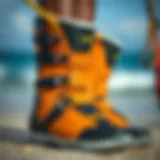Essential Guide to Kitesurf Board Bags for Enthusiasts
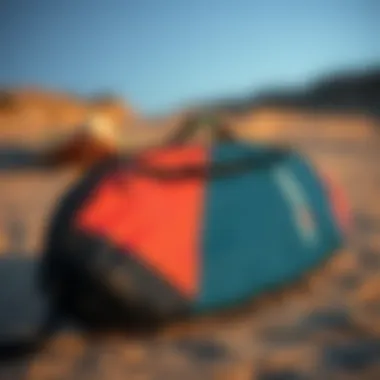
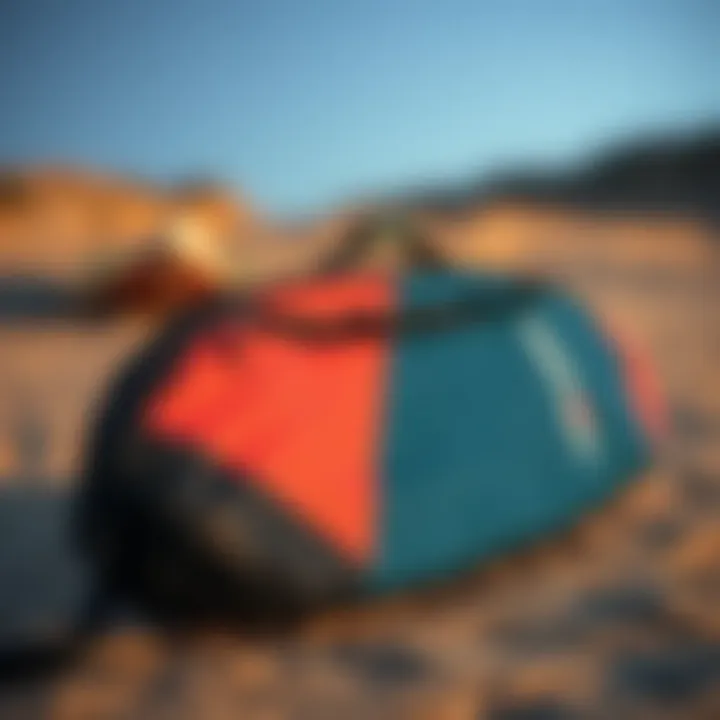
Intro
When it comes to kitesurfing, having the right gear is crucial for both performance and safety. One piece of equipment that often doesn't get enough attention is the kitesurf board bag. These bags may appear simple at first glance, but they play a pivotal role in ensuring your board remains in top-notch condition.
Importance of Board Bags
Kitesurf board bags serve as your board's first line of defense against the wear and tear of transportation and storage. Whether you're heading to the beach or traveling to an exotic location, a quality board bag protects your investment from dings, dents, and other potential damage.
Moreover, these bags can offer additional features such as padding, waterproof materials, and even compartments for other gear, making them an essential accessory for any kitesurfing enthusiast.
What to Expect in This Guide
This guide dives deep into various facets of kitesurf board bags. We will explore different types of bags, essential features that you should consider before purchasing, helpful maintenance tips to prolong the life of your bag, and recommendations for selecting the right one based on your kitesurfing style.
We aim to equip kitesurfers, instructors, and water sports coaches with the knowledge necessary to protect their gear. By understanding these elements, you can enhance your overall experience on the water and ensure that your equipment remains in stellar condition.
So, strap in; it's time to get to the nitty-gritty of kitesurf board bags!
"Protecting your gear isn’t just about keeping it pretty; it’s about longevity and performance out on the water."
With this foundation laid, let's delve into the techniques that every kiteboarding enthusiast should master.
Understanding Kitesurf Board Bags
Kitesurfing combines thrilling adventure with a connection to the elements, making it crucial for enthusiasts to protect their equipment. This is where kitesurf board bags come into play, acting as the unsung heroes of any kitesurfer’s gear collection. These bags not only safeguard the boards but also streamline the travel process, allowing for a seamless adventure from one beach to another. In this section, we will delve into the importance of understanding different aspects of kitesurf board bags to enhance your overall kitesurfing experience.
Definition and Purpose
Kitesurf board bags, as the name implies, are specially designed bags intended to carry and protect kitesurf boards. They come in various shapes and sizes, tailored to fit different types of boards and specific user needs. The primary goal of these bags goes beyond just carrying a board; they protect against rocks, sand, water, and the occasional bump that comes from a life spent on the move.
For instance, a kitesurf board bag can be thought of like a trusty sidekick. Just as superheroes wouldn't venture out without their protective gear, no kitesurfer should hit the road without a reliable bag. A well-chosen board bag can make a world of difference, ensuring that a board survives the rigors of transportation while maintaining its performance integrity.
Importance in Kitesurfing
Understanding the importance of kitesurf board bags is key for any kitesurfing devotee. Here are a few reasons why these bags matter:
- Protection: A quality bag protects against various forms of damage, be it abrasions from travel, UV rays, or water exposure.
- Convenience: They simplify transportation. Many board bags feature comfortable straps or wheels, making hauling easier, especially when lugging one’s gear to the beach feels like a task fit for Hercules.
- Organization: Kitesurf board bags often come with additional compartments for accessories like fins, leashes, or even repair kits. This helps keep everything in one place, avoiding the hassle of searching for that elusive fin or leash at a sandy shore.
- Travel Compliance: When flying with kitesurf gear, many airlines have specific requirements regarding bag dimensions and weight. Using a dedicated kitesurf board bag often meets these regulations and can save travelers from unexpected fees.
"Investing in the right kitesurf board bag is akin to setting a solid foundation for a house. It might not be visible, but it is fundamental for stability and longevity."
As kitesurfing gains popularity, the variety and demand for kitesurf board bags increase too. Therefore, comprehending their roles in protecting your gear, ensuring ease of travel, and providing organizational solutions is essential for anyone serious about the sport. After all, it's not just about riding the waves; it’s about riding them with confidence that your gear is well taken care of.
Types of Kitesurf Board Bags
Understanding the various types of kitesurf board bags is crucial for every kitesurfer who wants their gear to stay in top shape. Each bag type is tailored for specific needs, and knowing them ensures that your boards are protected whatever your kitesurfing adventures may involve.
Single Board Bags
Single board bags cater to kitesurfers who typically ride one board. They focus on a snug fit that minimizes movement, and they often are more lightweight compared to other bags. These bags serve not just to house the board but also to provide basic protection against minor impacts and scrapes during transport.
- Lightweight: Easier to carry around, especially during airport check-ins or on long walks to the beach.
- Compact Size: Fits most standard-sized boards, aiding in maneuverability.
- Affordability: Usually, budget-friendly, making them a great option for beginners.
However, there are downsides. Whether it's not enough padding or lack of extra space for accessories, single board bags may not be sufficient for every kitesurfer.
Double Board Bags
When it comes to hauling more gear, double board bags emerge as the champions. These bags can hold two boards and often come with extra space for other essentials like harnesses, kites, or wetsuits. They're a good choice for those who like to change up their gear based on different conditions.
- Versatility: Ideal for traveling with multiple boards; useful for varying wind conditions.
- Padded Protection: Better cushioning often exists, giving your boards a stronger defense against damage.
- Organizational Features: Often equipped with compartments for other kitesurfing essentials, making packing more convenient.
One needs to be aware of what you’re carrying, as double board bags can get heavy and cumbersome when packed to the brim.
Wheeled Board Bags
Wheeled board bags are a blessing when it comes to transporting hefty gear over long distances. No more sore shoulders and strained backs; these bags come equipped with wheels making them easy to maneuver, especially in crowded spots like airports.
- Effortless Transport: Dragging a wheeled bag is much easier than carrying one.
- Durability: Often made with robust materials to withstand rough handling during travel.
- Additional Space: Many models provide excellent padding as well as compartments for added items.
Yet, these bags can be bulky, requiring ample space when storing or loading into a vehicle.
Travel Board Bags
For those who take their kitesurfing internationally or over long distances, travel board bags are the ultimate choice. Designed specifically with airlines in mind, these bags often come with added padding and reinforced structures.
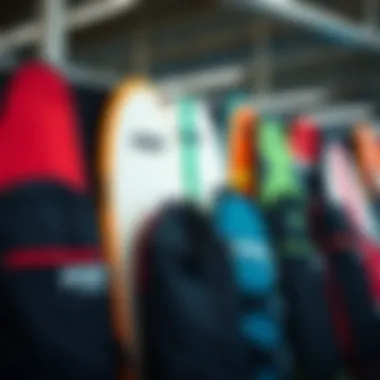
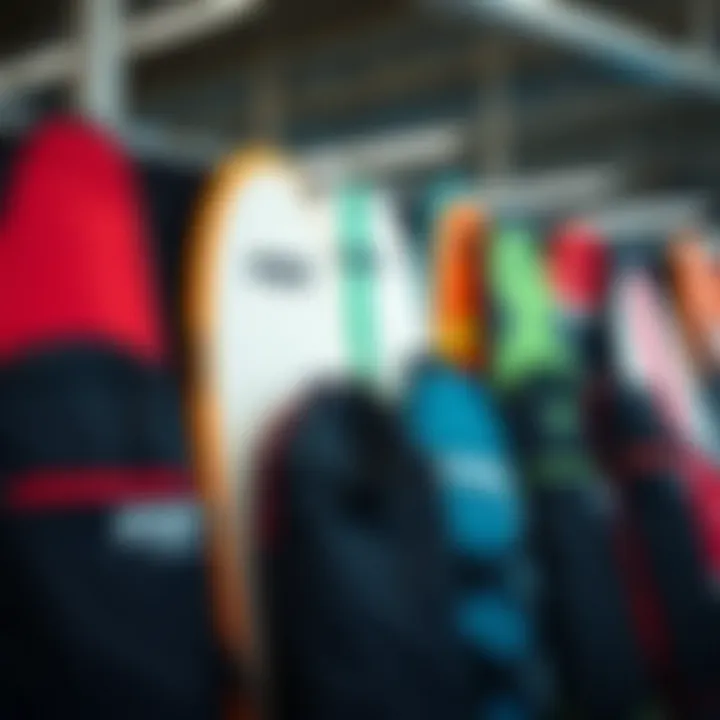
- Airline Friendly: Often meets the size regulations required by airlines, providing peace of mind during travel.
- Robust Construction: High-quality materials hold up to potential roughhousing by baggage handlers.
- Extra Storage: Space for other gear, ensuring you pack everything needed without hassle.
Of course, travel board bags are typically more expensive, and their size can make them less suitable for day-to-day use.
Overall, the type of board bag you choose hinges on personal needs, travel habits, and budget. Selecting the right one can greatly enhance your kitesurfing experience, ensuring that your gear is always in top form, ready to catch those waves.
Key Features to Look For
When you venture into the world of kitesurfing, having the right board bag is essential. Not only does it protect your precious equipment from scratches and weather elements, but it also plays a pivotal role in your overall kitesurfing experience. So, understanding the key features to look for in a kitesurf board bag can save you a heap of trouble down the line. These features are like the nuts and bolts of the bag itself; they keep everything together while ensuring that your gear remains safe and sound.
Material and Durability
A board bag needs to withstand a lot of wear and tear, and the material used is crucial in determining its durability.
Fabric Types
The fabric types used in kitesurf board bags vary greatly, with options like nylon, polyester, and even tarpaulin making the scene. Nylon is often favored for its lightweight properties and resilience, offering a good balance between weight and protection. On the other hand, polyester typically provides a more robust option due to its higher resistance to UV light and tearing.
Nylon generally tends to be a better choice for those looking for an ultra-light bag without compromising on durability. However, if you’re one to frequent the beach in harsher conditions, you might opt for polyester. It’s thicker and can stand up to sand and salt without breaking a sweat. Ultimately, your choice will hinge on your specific needs and the conditions you most often encounter.
Water Resistance
When you’re out on the sea, the last thing you want is your gear getting drenched. This is where water resistance comes into play. Bags that are treated with water-resistant coatings or made from waterproof materials can keep your equipment dry, even when the weather’s playing hard to get. Nylon bags can be water-resistant, but it’s always a safe bet to check for additional treatments.
The standout feature of water-resistant bags is their ability to keep your investment safe from the elements. However, some may find that completely waterproof options can be cumbersome and more expensive, leaving you with a decision to make—your comfort against your equipment care.
Padding and Protection
To ensure your board doesn't end up looking like a battered old shoe, padding is a necessity.
Foam Padding
Foam padding is often the first thing you’ll notice when you pick up a kitesurf board bag. The thickness and quality of the foam play a significant role in protecting the board during transport. Lightweight foam is popular since it offers adequate cushioning without adding extra weight. Some bags utilize high-density foam, which not only cushions impacts but also keeps the board snugly in place, preventing it from shifting around.
While this padding style is beneficial, it might take some additional care and attention to avoid degradation over time. Too much exposure to the elements could lead foam to compress and lose efficiency.
Reinforced Areas
Think about the high-impact zones of any gear, and you’ll find that the edges and corners of your board bag are right up there. Many bags come with reinforced areas to ensure these vulnerable spots are safeguarded against bumps and scrapes. This is particularly important if you’re planning extensive travels, be it flying or just tossing your bag in the truck.
The big bonus here is that reinforced areas can significantly prolong the lifespan of the board bag. However, keep in mind that reinforced spots can add some weight to the bag, which might be something to consider if you’re aiming for a lightweight option.
Size and Fit
Not all boards are created equal, and therefore, neither are board bags.
Dimensions for Different Boards
The right dimensions for your board bag are vital. A bag that’s too small won’t fit your board, while one that’s too large can expose your equipment to unnecessary movement and potential damage. Therefore, finding precise dimensions for different board shapes is key. Many board bags come with sizing charts to help you select the right fit based on your board type, whether you’re packing a twintip or a directional board.
While it can be tempting to buy a bag that can fit multiple boards, the ideal approach is to find one that fits your primary board snugly, as it will provide the best protection. Just keep in mind, a bag designed specifically for your board type will give you that little extra insurance against wear and tear.
Adjustability Features
A board bag with adjustability features makes life a whole lot easier. Straps that allow you to tighten the bag over your gear can cut down on potential shifts during transport, ensuring things stay put. Adjustable compartments can also cater to additional gear, such as kites or harnesses, and make organization a breeze.
On the downside, not every adjustability feature is made equal. Some might be more cumbersome than beneficial, so it’s worth testing them out before making a final decision.
Straps and Handles
Let’s face it; carrying a bulky board bag isn’t always easy.
Types of Handles
If you’ve ever lugged around a bag that simply refused to cooperate, you’ll know the importance of having quality handles. Many kitesurf board bags are designed with multiple handle options—side handles, top handles, even shoulder straps.
A sturdy shoulder strap can make it easier to carry your bag long distances, especially if you anticipate wandering across sand or rocky terrains. However, some handles may lack comfort or grip, turning your jaunt to the beach into a forearm workout.
Adjustability and Comfort
Features that promote adjustability and comfort are paramount, particularly when it comes to long hauls. Cushioned handles can provide that extra level of comfort while adjusting for different user preferences can help each kiter find their sweet spot when carrying the bag. Some bags also come with contoured straps that can reduce back strain.
Yet again, it’s essential to note that extra comfort features might come with bulkier designs, leaving a potential trade-off between luxury and lightweight convenience. In any case, comfort goes a long way, so consider this feature carefully as you make your choice.
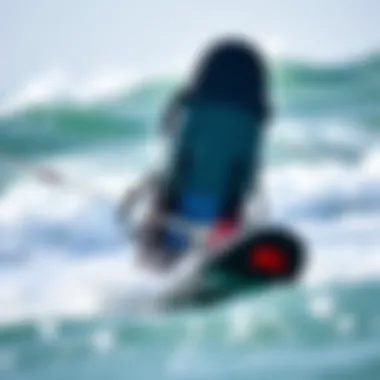
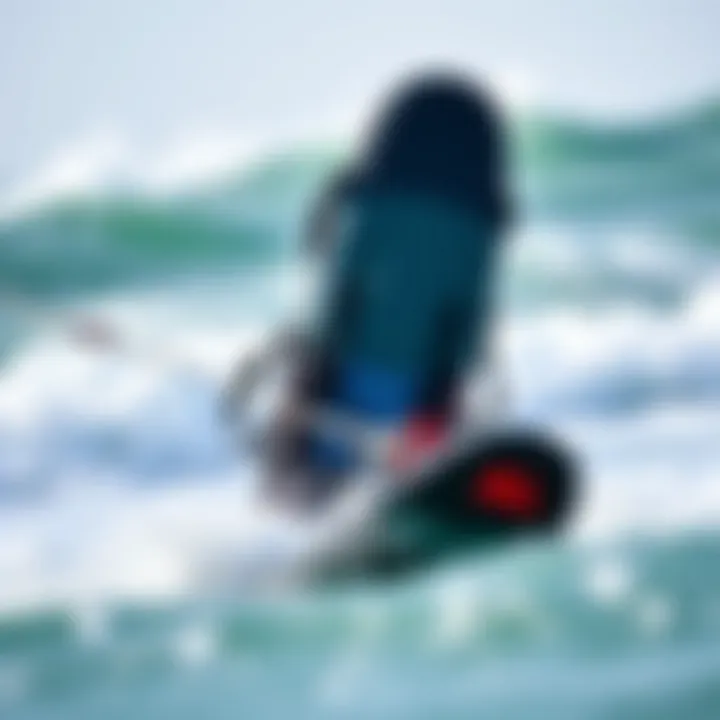
Choosing the right kitesurf board bag is not merely a matter of preference; it’s about putting your best foot forward—or should I say foot on the board. Understanding these key features allows you to safeguard your gear and enhance your kitesurfing adventures.
Maintenance and Care
Caring for your kitesurf board bag is just as critical as protecting your kitesurfing gear itself. A well-maintained bag will not only extend its lifespan but also ensure that your equipment is safeguarded against potential damage. This section will delve into essential care tips and maintenance practices that every kitesurfer should consider. By understanding the nuances between cleaning techniques and repair solutions, you can keep your board bag in top shape, ensuring it's ready for your next adventure.
Cleaning Techniques
Material Specific Cleaning
Different materials compose kitesurf board bags – nylon, canvas, and polyester are common options. Each material offers distinct characteristics and requires unique cleaning methods to maintain its integrity. For instance, a nylon bag, known for its lightweight and durable quality, is best cleaned with a mild soap solution and a soft sponge. This approach is gentle enough to prevent any abrasion and keeps the fabric from losing its waterproofing abilities.
However, canvas bags present a different challenge. They often require a more thorough deep cleaning, involving a gentle wash in cold water or even a specialized canvas cleaner. The key advantage of material-specific cleaning lies in its potential to preserve the fabric's original benefits, such as water resistance or breathability. Neglecting this can lead not only to visible dirt but also to material degradation.
Pros:
- Tailored care ensures longevity.
- Retains protective qualities of the fabric.
Cons:
- More intricate cleaning may require additional time or products.
Storing Tips
Proper storage of your kitesurf board bag is another crucial aspect of its maintenance. After a long day on the water, it can be tempting to toss the bag in the corner and call it a day. However, storing it correctly will deter mold growth and preserve its structural quality. Ideally, find a dry, temperate area away from direct sunlight for storage. Storing the bag in a folded manner can cause creasing, so hang it if possible or store it flat.
One unique feature of thoughtful storage is the use of desiccants, which can be placed inside the bag to absorb any excess moisture and prevent mustiness. This not only keeps your bag fresh but also maintains the integrity of your board and accessories within.
Pros:
- Prevents moisture build-up and odors.
- Maintains bag's shape.
Cons:
- Requires a bit of planning and space allocation.
Repairing Minor Damage
When accidents happen, knowing how to tackle minor damage can save your kitesurf board bag from needing a costly replacement. Understanding the signs of wear early allows you to act before issues escalate.
Identifying Issues
Routine inspections of your bag can help you spot problems like fabric tears or zipper malfunctions. Catching these issues early makes it easier to fix without compromising the bag’s durability. For example, a small tear may be easily stitchable, especially when identified immediately. Regular assessments make minor repairs possible and keep your board bag functioning optimally.
Pros:
- Early detection prevents larger issues.
- Saves money on repairs or replacements.
Cons:
- Requires regular checks, which may be overlooked.
DIY Repair Solutions
Many minor damages can be fixed with simple DIY solutions, ensuring you're not left down an expensive path to professional repairs. For instance, using a strong GORILLA tape on minor rips can create a durable patch until you can do a proper fix. Crafting a small kit with basic tools like needle and thread, along with some fabric adhesive, can make you prepared for any surprise damages mid-season.
Additionally, you might find online tutorials and community forums that offer innovative ways to handle repairs. Collaborating with other enthusiasts can share insights into efficient, low-cost solutions for your specific bag type.
Pros:
- Cost-effective and accessible solutions.
- Fosters a sense of independence and camaraderie in the kitesurfing community.
Cons:
- May not account for all types of damage, especially severe cases.
Choosing the Right Kitesurf Board Bag
Selecting the right kitesurf board bag isn't just a matter of convenience; it's pivotal to ensuring the longevity and performance of your gear. The right bag not only protects your board during transport but also offers practical features that cater to your specific kitesurfing adventures. Whether you're traveling to a local spot for the day or embarking on a cross-country adventure, understanding how to choose a bag suited to your needs can significantly enhance your kitesurfing experience.
Assessing Your Kitesurfing Needs
Usage Frequency


When you think about how often you hit the water, consider how that influences your bag choice. If you're the type who's out on the waves every weekend, a robust bag with extra padding might be the way to go. It's tailored for daily wear and tear, protecting your board from not just bumps but also from the elements. Frequent usage means these bags often come with enhanced waterproof features too—definitely a plus when you're dealing with unpredictable weather.
A higher usage frequency also opens the door for more personalized features. For instance, if you notice wear and tear quickly, investing in a bag that offers replaceable parts could save you money down the road, making the initial investment worthwhile. However, if your kitesurfing is sporadic, you might not feel the need to splurge. Finding that sweet spot in your buying decision can lead to both satisfaction and savings.
Travel Requirements
Now, let’s chat about travel. Not all kitesurfing adventures require the same degree of portability. If you frequently hop on planes or endure long car rides, you’ll want a bag that emphasizes convenience and ease of transport. A wheeled board bag can make life a lot simpler, allowing for hassle-free movement. For those who often drive to their kitesurfing destinations, a traditional padded bag might do just fine.
Additionally, considering the size of your board and the type of wheels on the bag can drastically affect your travel experience. A bag that accommodates two boards with multiple compartments might be appealing if you're looking to broaden your options without carrying extra gear. Ultimately, assessing your travel needs straight away saves headaches later, whether that’s at check-in or when lugging bags through sandy beaches.
Budget Considerations
Cost vs. Quality
Every kitesurfer knows that money doesn't grow on trees. When it comes to kitesurf board bags, the interplay between cost and quality tells a vital story. Splurging for a high-end bag often means you're investing in durability, added features, and greater protection for your equipment. Think about what you're willing to extend for an extra layer of peace of mind while knowing you're protecting that precious board of yours.
On the other hand, the budget-friendly options may catch your eye, promising much at a lower price tag. Just keep in mind that these bags might not offer the same level of protection or longevity. A sensible approach might be finding a middle ground—doing your research, reading reviews, and maybe even seeking out second-hand bags that hold up well under pressure.
Long-term Investments
At the end of the day, think of a kitesurf board bag as more than a simple cost. It’s a long-term investment. High-quality bags often come with warranties or promises of durability, emphasizing that they can withstand years of use. There's an unspoken guarantee that your equipment, through thick and thin, will remain intact due to the solid materials and smart design.
However, this doesn’t mean you should overlook the varying features available. Some bags offer extra storage compartments for tools or smaller items, adding value to your overall investment. Weighing the options clearly will help affirm whether you want a short-term solution or if you're committed to maintaining your gear over several kitesurfing seasons.
"Selecting the right board bag isn’t merely about style; it’s about making sure your gear hits the waves protected and ready for action, one adventure at a time."
Whether you’re just starting out in kitesurfing or you’re a seasoned veteran, understanding these aspects when choosing your board bag will enrich your time on the water.
Popular Brands and Models
Choosing the right kitesurf board bag can seem like navigating a maze. With so many options out there, understanding the various brands and models available becomes essential. Each brand has its own flavor, catering to different preferences and purposes. Knowing what’s on the market can help you make informed decisions, thereby enhancing your overall kitesurfing experience. Let’s explore the top brands and the features that set their offerings apart.
Brand Overview
Brand A
Brand A has made quite a name for itself in the kitesurfing community. Renowned for its attention to detail, this brand focuses primarily on durability and user-friendly designs. One distinguishing characteristic of Brand A is its use of high-grade materials that withstand the rigors of travel and use.
Key Feature: The reinforced stitching found throughout Brand A's bags is particularly noteworthy. This unique touch not only extends the product's life but also provides additional protection for your gear. While the price tag may be on the higher side, many customers find that the durability justifies the investment, making it a smart choice for serious kiteboarders and instructors alike.
Brand B
Brand B is another popular name, well recognized for its versatility and innovative designs. The wide variety of sizes and styles available speaks volumes about its commitment to serving diverse needs. It’s a brand that consistently aims to balance cost and performance, appealing to both newbies and seasoned pros.
Key Feature: One of Brand B's standout features is its lightweight design. This can be a game-changer for those who travel frequently. However, some users note that, despite its positive attributes, the fabric may not be as resilient as rival brands. That said, the affordability makes it an attractive option for those just getting their feet wet in the kitesurfing world.
Model Comparisons
Model vs. Model Y
When comparing Model X to Model Y, it becomes evident that both contenders have their merits but serve slightly different needs. Model X shines with its high-padded protection, ideal for those who prioritize gear safety over everything else.
Key Characteristic: The thick foam padding of Model X is a game changer for protecting your boards and kites against dings and scratches. However, this added protection does come at a cost, as it can make the bag heavier.
On the flip side, Model Y offers a streamlined design, which is perfect for those who want portability and ease of handling. Advantages of Model Y include its lightweight structure and compact size, but it may lack the robust padding that comes with Model X. Thus, your choice may hinge on whether you prioritize protection or convenience.
User Experiences
User experiences can be a valuable resource when selecting a kitesurf board bag. The community often shares unique insights that go beyond marketing claims.
Characteristic: Many fishermen and fliers rave about the comfort of the handle straps on certain models. This feature drastically enhances usability, particularly when lugging the bag around.
Real-world feedback often underscores the importance of choosing a bag that matches one’s lifestyle. Those who frequently travel by air note that bags with reinforced corners resonate more. However, some users do mention that fetching an ideal fit can involve trial and error. It’s important to consider the experiences of others while also aligning them with personal preferences.
"Selecting a board bag should reflect not just what you need, but also how you plan to use it. The right bag can be tailored to your sailing style, travel habits, and gear requirements."
By understanding these popular brands and models, you arm yourself with essential knowledge. Whether opting for the reliability of Brand A or the innovative options from Brand B, making an informed choice can significantly enhance your kitesurfing expeditions.
Finale
As we draw this guide to a close, it’s essential to reflect on the various insights shared about kitesurf board bags. The right board bag does more than simply hold your board; it protects a significant investment critical to your kitesurfing adventures. Selecting the right bag can enhance your experience, ensuring your gear remains safe from the rigors of transportation and storage.
Recap of Key Points
- Understanding the Variety: From single to double board bags, knowing the types available is fundamental. Each comes with its own purpose and advantages, tailored to different users' needs.
- Importance of Features: Key features like material durability, padding, and size are paramount. These details directly impact how well your bag can protect your board.
- Maintenance Matters: Keeping your board bag in top shape isn't just about storage; it's about longevity. Regular cleaning and minor repairs can help maintain its function.
- Choosing Wisely: Assessing your personal kitesurfing habits and budget is vital in making an informed decision. Cost should align with the quality and function you expect from the bag.
Final Thoughts on Kitesurf Board Bags
Investing in a suitable kitesurf board bag can make all the difference between a smooth journey to the water and a bumpy ride full of worries. The right protection ensures your board is secure, making it easier to focus on perfecting your skills rather than worrying about the integrity of your gear. Always keep in mind your unique needs and circumstances; whether it’s frequent travel or just local excursions, there’s a bag out there fit just for you.
Choosing wisely means considering the long-term benefits of protecting your investment. Remember, kitesurfing is not just a hobby; it’s a lifestyle. Your gear is an extension of that, and a quality board bag is integral to that experience. Happy kitesurfing!














